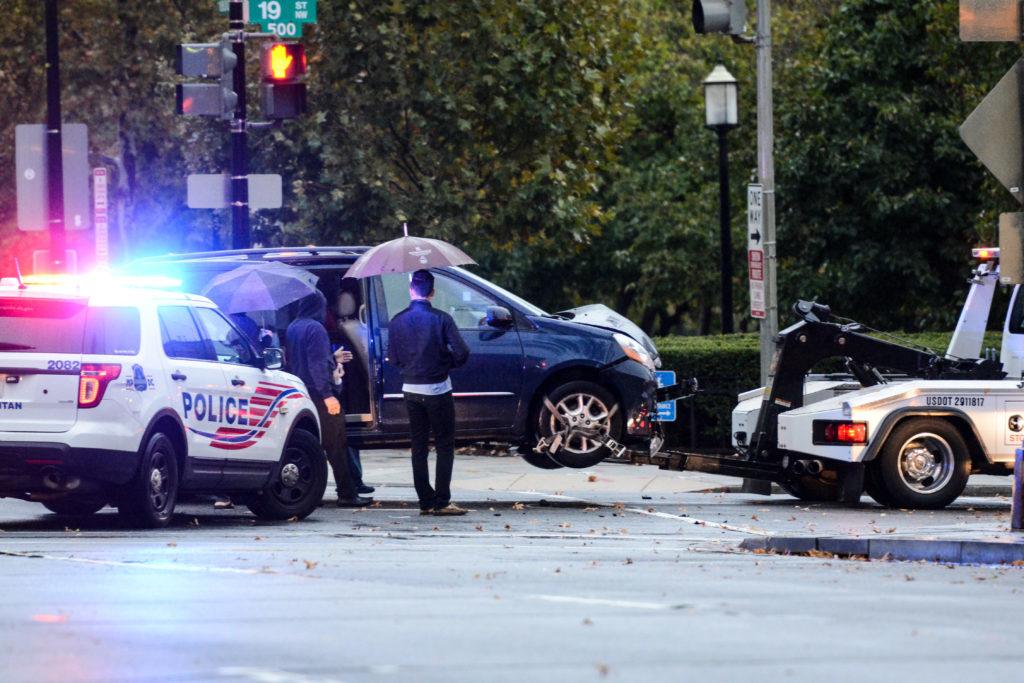Yonah Bromberg Gaber | Graphics Editor
Source: Office of the Chief Technology Officer
The area near Washington Circle and 23rd Street is the most dangerous place for drivers near the Foggy Bottom Campus.
Since May 2008, 327 vehicle crashes have occurred in the traffic circle or along the stretch of 23rd Street leading up to it – the most out of any area near campus, according to an analysis of crash data from the D.C. Department of Transportation. Community leaders said merging lanes and frequent exits make it difficult for drivers to navigate the circle and cause crashes.
The analysis includes the area roughly between E Street north to Pennsylvania Avenue, including Washington Circle and 19th Street west to 24th Street.
There were 1,636 vehicle crashes in the area analyzed since May 2008, which resulted in 351 injuries and two deaths. The number of collisions rose sharply last year to 307 after crashes had stayed roughly consistent between 130 and 200 annually in previous years.
Near campus, more crashes have occurred along two-way streets like H Street than one-way streets like F or G streets. Between May 2008 and September 2017, there were 36 accidents on H Street between 20th and 22nd streets, compared to 13 on the same stretch of G Street and 22 on F Street.
“There’s a lot of merging and weaving that takes place. There’s a lot of confusion.”
Major thoroughfares like Pennsylvania and Virginia Avenue were also hot spots for car crashes. There were 183 collisions that occurred along Pennsylvania Avenue between 19th Street and Washington Circle and 63 along the part of Virginia Avenue next to campus.
DDOT partners with the Metropolitan Police Department and the Office of the Chief Technology Officer to document recorded crashes across the city, including those reported by citizens within five days of the crash, DDOT spokeswoman Maura Danehey said.
“Through these efforts, DDOT provides improvements to address safety concerns, including changes to traffic signage and roadway markings, upgrades to intersection control and modifications to roadway circulation or intersection operation,” Danehey said.
Danehey said the speed of vehicles, number and design of turns, traffic control systems like street lights and signs, roadway lighting and pavement conditions could all influence the number and severity of crashes in a given area.
She added that DDOT plans to improve traffic safety in the Foggy Bottom area with the planned addition of bicycle and bus lanes on Pennsylvania Avenue between Washington Circle and 17th Street near campus. There is currently no set timeline to install the upgrades.
Patrick Kennedy, the chairman of the Foggy Bottom and West End Advisory Neighborhood Commission, a local governing group, said Washington Circle can be difficult to navigate for unfamiliar drivers because there are seven different entrance and exit points along the circle, often disorienting drivers.
“There’s a lot of merging and weaving that takes place,” he said. “There’s a lot of confusion.”
But Kennedy said the crashes in Washington Circle are typically minor because drivers can’t travel too fast through the circle. He said he is more concerned about straight-shot roads, like Virginia Avenue, where drivers travel at higher rates of speed.
“Those roads are mostly straight and wide, and so drivers feel comfortable taking them at a rate of speed that I don’t think is appropriate for an urban area,” he said.
But Kennedy said most of the streets on campus are safe because vehicles travel slowly to avoid students who are constantly crossing area roads.
There have been 45 crashes involving a pedestrian on campus since May 2008 – about 2.7 percent of all accidents, according to the data. Fourteen of those incidents happened so far this year, resulting in 12 injuries and no deaths, according to the data.
Eve Zhurbinskiy, an ANC commissioner and a senior, said she is most concerned about incidents on H Street between District House and Kogan Plaza, where students often cross the street without paying attention to their surroundings. She proposed adding a crosswalk at that location in February, but details have not been finalized.
“The more that a city plans and designates spaces for people in all modes, not just cars – but people walking and biking, it is going to be safer.”
“I think there’s been some steady progress there,” Zhurbinskiy said. “DDOT has agreed to put in a crosswalk, but now it’s just a matter of funding and whether DDOT wants to fund it or whether GW wants to fund it.”
There have been 21 crashes on that stretch of H Street since 2008.
In an incident last year, a car ran into a student in a hit-and-run at the intersection of 20th and G streets. Two pedestrians were also struck on H Street in 2011.
Over the past nine years, the most collision-prone intersections on campus include 21st Street and Pennsylvania Avenue and 19th and E streets, which each saw 18 incidents.
Kathleen Ferrier, the policy and communications director of Vision Zero Network, a group aiming for zero traffic fatalities in D.C., said as more people begin to walk in cities across the country, they get hit more often.
“The more that a city plans and designates spaces for people in all modes, not just cars – but people walking and biking, it is going to be safer,” she said.





